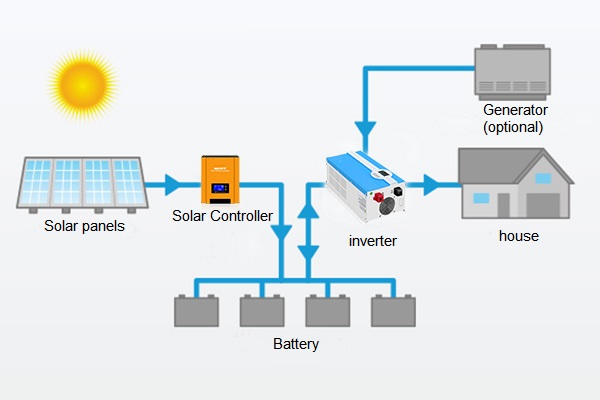
As solar technology continues to develop, an increasing number of households consider adopting solar energy panels to power their home appliances. However, for most end-users, connecting solar energy panels to home appliances may be an unfamiliar task. In this article, we will explore how to correctly connect solar energy panels to meet household electricity needs.
First, understand that the electricity provided by solar energy panels is direct current (DC). Whereas, most household appliances use alternating current (AC). Therefore, before connecting solar energy panels, we need a device to convert the type of current, which is the so-called DC-AC solar inverter.
A solar charge controller is connected to solar energy panels, responsible for monitoring and controlling the charging process of the battery. The direct current generated by the battery is then converted into alternating current suitable for home appliances through the solar inverter. It is worth noting that some solar charge controllers may already be integrated within the inverter, but the working principle remains largely the same.

To better understand the connection process, we can refer to the wiring diagram of an off-grid solar power system. The solar charge controller is connected to solar energy panels, responsible for managing the charging state of the battery. The direct current generated by the battery is converted into alternating current through the solar inverter. Finally, the inverter's output of alternating current will supply the home appliances.
Understanding how to connect solar energy panels is crucial for a home off-grid solar system. By properly connecting inverters and a sufficient number of solar energy panels, the electricity generation efficiency can be improved, making the most out of solar energy resources. The inverter, as a key component of the system, is vital for the normal operation of the entire solar power system.
When choosing an off-grid solar system, ensuring you understand the function and connection method of each component will help ensure the system's stable operation, providing your home appliances with reliable clean energy.
Yes, Anern supplies solar street lighting solutions as part of its solar energy product portfolio, including integrated solar-powered lighting systems for public and infrastructure applications.
We use SMD5730, EPISTAR and LG 3030 LED chips, with high light efficiency, low power consumption, wide luminous Angle and other characteristics.
Anern's energy storage systems are used in the following solar applications:
Residential Backup Power:
For home use during power outages, providing up to 6 hours of continuous power for average household consumption. These systems reduce grid reliance and electricity bills while storing excess solar energy.
Commercial and Industrial Energy Management:
Installed in factories and businesses to store excess solar energy, reduce peak-hour grid consumption, and lower electricity costs. Systems are deployed in secure, ventilated locations for stability.
Off-Grid Infrastructure:
Supports meteorological/hydrological observation equipment and other critical infrastructure in remote areas without grid coverage. Battery banks store solar energy converted via inverters for reliable operation.
Agricultural Operations:
Powers farms by converting stored solar energy into AC electricity, maintaining agricultural activities during outages or grid instability.
Large-Scale Solar Projects:
Used in independent photovoltaic power stations ranging from 10KW to 50MW capacity, enabled by parallel-connected hybrid inverters for solar energy conversion and storage.
Generally 3-10 years warranty , vary from different items.
Anern is a Chinese solar energy solutions manufacturer supplying solar inverters, lithium battery energy storage systems, solar panels, integrated on-grid and off-grid solar systems, and solar street lighting products for international markets.